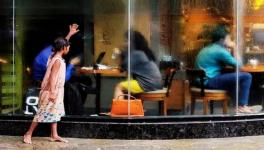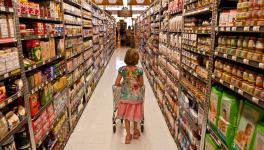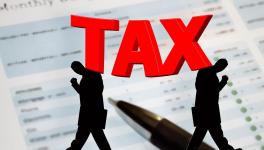First In 46 Years, Food Consumption Falls, Modi Govt Scraps Consumer Spending Survey
Image for representational use only.Image Courtesy : Outlook
-
Poverty and malnutrition seem to be worsening in India as food spending by rural India—which is the vast majority of the 1.4 billion people in the world’s largest democracy—has fallen for the first time in real terms (adjusted for inflation) in 46 years, as per the leaked excerpts of the NSO’s Consumer Expenditure Survey for 2017-18, which was first suppressed and then scrapped by the Narendra Modi-led BJP government.
-
In 2017-18, an average person in rural India spends an average of Rs 580 per month on food consumption, as per the survey.
Overall (food and non-food) consumption spending in villages declined by 8.8% in 2017-18 while it rose by 2% in cities as compared to 2011-12 (when the last NSO consumption spending survey took place) — indicating an intensifying and ever-widening gap between rich India concentrated in the urban and suburban centres and poor India that resides scattered across the rural parts.
The monthly per capita consumption expenditure (MPCE) has been calculated in real terms (adjusted for inflation), keeping 2009-10 as the base year, as per the news report. In 2011-12, the real MPCE had risen 13% over a period of two years.
The Household Consumer Expenditure in India data shows a fall of 3.7% in the average amount of money spent by a person in a month, which fell from Rs 1,501 in 2011-12 to Rs 1,446 in 2017-18.
The survey was approved for release by a committee on June 19, 2019—and had been conducted by the National Sample Survey Organisation between July 2017 and June 2018—but it was withheld for its “adverse” findings that could have damaged the ruling Bharatiya Janata Party’s regime’s PR (public relations) work and at least hold it accountable among rich India, which has to hold itself accountable too, until it was leaked to the press, a day after which it was officially declared scrapped.
“In the last five decades at least, there has never been a period that consumption expenditure in real terms has declined. This data clearly shows that poverty levels would have gone up substantially. A back of the envelope calculation would suggest that the percentage of population in poverty would have gone up by at least 10 percentage points,” Himanshu, associate professor in economics at Jawaharlal Nehru University, told the Business Standard.
The last time that consumption fell in real terms as per an NSO survey was in 1972-73 owing to global oil crisis at that time, he told the newspaper. Earlier in the mid-1960s, consumption had fallen due to a domestic food crisis.
The downfall in food consumption for the rural socio-economic sections mean that poverty is shooting up and so purchasing powers are falling and failing to fulfil even the most fundamental demand of food, and hence demand has been falling which damages the financial economy and further leads to unemployment—which is also at a 45-year high.
In 2017-18, rural people on average spent Rs 580 on a monthly basis on food—a 10% decline from Rs 643 in 2011-12 (both in real terms).
Urban people, on the other hand, spent an average of Rs 946 each month in 2017-18 as against Rs 943 in 2011-12, reflecting a marginal increase over these six years.
“It’s a real concern from the point of view of welfare of the people. A fall in food spending, especially in villages, shows that malnutrition has increased. It would be fair to say that poverty must have increased significantly,” said former Planning Commission Member Abhijit Sen as quoted in a Business Standard newsreport.
No wonder India is 16th from the bottom in the Global Hunger Index in its 2019 report.
In villages, people cut their expenditure on all food items, except on milk and related products. Across urban and rural areas, people spent much less on essential cooking items, such as edible oil, pulses, sugar, salt and spices.
The spending on non-food consumer items—such as durable goods, clothing, education, and rent, saw a decline by 7.6% in 2017-18 in rural parts and an increase by 3.8% in urban parts as compared to 2011-12.
As for food, the consumption of cereals and cereal substitutes was hit the most among the rural population—it fell by 20.4% for rural India while urban India saw a fall of 7.9%.
The total food consumption expenditure fell by 9.8% for rural India while it marginally increased by 0.2% for urban India.
But instead of facing the findings and acting upon them, the Narendra Modi-led BJP government has shelved the survey over “data quality issues”.
The Ministry of Statistics and Programme Implementation is “separately examining the feasibility of conducting the next consumer expenditure survey in 2020-21 and 2021-22 after incorporating all data quality refinements in the survey process,” said the government’s official statement released on November 15 after the leaked parts were out in the business press the same morning.
The government said it found deficiencies in the survey report and referred it to a sub-committee.
It argued that the Advisory Committee on National Accounts Statistics had recommended a change in base for the GDP series from 2017-18, as it was not considered to be an “appropriate year” — while it is not explained why the year is not “appropriate”, it is explicitly because it was just a few months after demonetisation and also a time of GST implementation.
But there are precedents of reports based on an “unusual year” being released and not supressed.
“During my tenure as chief statistician, the consumer expenditure survey took place in 2009-10, which coincided with the worst drought in 40 years and a global economic crisis. So, we had decided to change the base year to 2011-12, but had still released the 2009-10 report. We didn’t suppress the data,” former chief statistician Pronab Sen told Business Standard.
The BJP government too has set precedents of suppressing other survey reports, significantly such as the NSSO’s Periodic Labour Force Survey (PLFS) report— which showed unemployment at a 45-year-high.
Indeed, the regime has suppressed at least three reports on the state of the economy, including the 6th annual employment-unemployment survey by the Labour Bureau and a Labour Bureau survey on the number of jobs created under MUDRA.
The government statement on the scrapping of the 2017-18 consumer expenditure survey also posed concerns related to the survey’s ability to capture consumption of social services by households, especially on health and education.
It also said a committee scrutinising the survey report had noted certain “discrepancies” and given some recommendations including a change in the survey methodology and others for improving “data quality” on a “concurrent basis”.
Consumer expenditure surveys are usually conducted with a gap of five years. In 2011-12, however, the survey was conducted after two years, as during the previous round of survey in 2009-10, it was a drought year. The findings of both these reports are available in the public domain.
As for the “discrepancy”—cited by the government as one of the reasons for scrapping the survey report altogether—between the national accounts numbers and findings of the survey report of 2017-18 on consumer expenditure, it is not and has never been a problem, as this Business Standard article elaborates.
Get the latest reports & analysis with people's perspective on Protests, movements & deep analytical videos, discussions of the current affairs in your Telegram app. Subscribe to NewsClick's Telegram channel & get Real-Time updates on stories, as they get published on our website.























